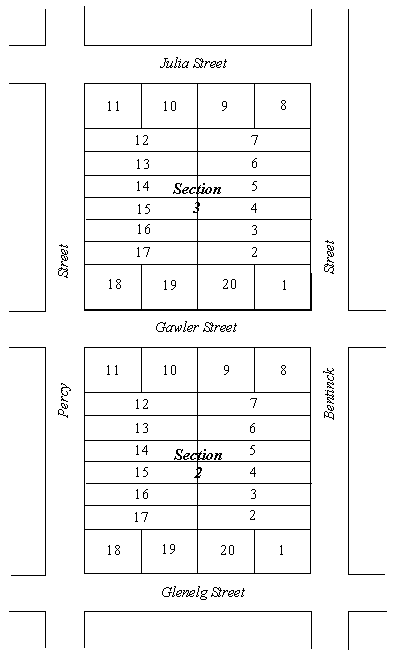|
The coastal town of Portland, Victoria, is situated some 360 kilometres west of the City of Melbourne. Portland was the first permanent settlement in the Colony of Victoria, and as such was expected to become the principal settlement of the Colony, in effect, the Capital.
In 1833 a Whaling station was established on Portland Bay for Henry Reed of Launceston, Van Diemen's Land (Tasmania). Later that year Edward Henty of Launceston arranged to call at Portland Bay on a return trip to Launceston from Western Australia, aboard the schooner Thistle. Henty was "...much pleased with the bay and what [he] thought a good site for a town..."(16), and returned to Launceston to report to his family his findings. The waters afforded prosperous fishing, the climate was good, and the land rich and fertile, so on 19 November 1834 Henty returned to Portland Bay and squatted.
Edward Henty and his brother Frank soon relocated to Portland Bay. Pioneers since 1829 they were no strangers to the task of establishing themselves in remote locations, and within months the Henty brothers had transported supplies, stock and servants from Launceston to the mainland. The settlement that they established grew steadily until 1840, when the town of Portland was surveyed.
Town allotments were auctioned in Melbourne and "the prices realised were far beyond expectations", resulting in a flurry of building activity.
The Port Phillip Patriot newspaper (17) reported the sales on Saturday 10 October 1840 :
SALE OF CROWN LANDS AT PORTLAND BAY
The first sale of Government Lands at Portland Bay took place on Thursday last. They consisted of Town, suburban, and Cultivation allotments, and the prices realised were far beyond expectation, especially some of the town lots. We are beginning to seriously doubt the sanity of some of our fellow colonists...
The township was soon established, and the need to import goods from major trade centres such as Launceston was alleviated. Government authorities and Police were appointed to the town, a newspaper established (The Portland Gazette), a private school opened, and a substantial pier was constructed.

Plan of the First Portland Land Sale.
The town was set out in a grid fashion of numbered Sections, each Section containing 20 Blocks, each Block being an area of two roods (see Appendix M). The first Sections sold were Sections 2 and 3, and consequently contain some of the oldest buildings in the town, and naturally Gawler Street became the first town centre. The town continued to develop from these beginnings,
and greatly benefited from the Gold Rush years of the 1850's. An increase in shipping activity at Portland Bay saw 11,000 assisted immigrants arrive in the town over a seven year period. Many came lured by the promise of fortune at the gold fields, others to benefit from the business opportunities that the young town offered. It was into this environment that the Hale family
from Kent arrived.
Upon arrival in Portland, Victoria, in 1853, the Hale family from Kent took possession of land situated on Allotment 20 in Glenelg Street, although early rate records erroneously record this as Allotment 19. It contained a small building, and was situated where No. 10 stands today. At that time cottages were constructed at the front and rear of these
blocks, and it appears that initially William and Harriet Hale occupied a small building somewhere on this site. Research suggests that the timber cottage that now occupies the site at No. 10 was built sometime between 1853 and 1856, and therefore presumably by William Hale, as he was a Carpenter and Builder by trade and was working as a Builder in the town. Certainly this building was in existence
by February 1857, as William and Harriet's daughter Jane was born there in that month.

The Hale family homes at 10 and 8 Glenelg Street, Portland, Victoria.
Click the image for more information about Portland
and these two properties.
At this time Portland's traders were prospering, supplying local farmers and those setting out on the long journey to the gold fields. This prosperity resulted in a number of substantial buildings being erected during this period, and many of Portland's bluestone buildings date from this time. A Benevolent Asylum (hospital) was built in the 1850's. The building trade was booming,
local builders hiring tradesmen from the immigrant ships arriving in Portland Bay.
The foundation stone of Portland's first Wesleyan Chapel was laid on 11 October 1843, on land in Percy Street donated by William McDowell. The Reverend William Lightbody was Portland's first Wesleyan Minister, during the years 1851-1855, and later baptised the first generation of Australian Hales. Work commenced on a new Wesleyan Church in Percy Street in 1865. There is little doubt
that William Hale, a Builder and Joiner by trade, would have been involved in the construction of the New Church, completed in 1867 to replace the original Wesleyan Chapel.
The foundation stone of St. Stephen's Church of England was laid on 24 March 1855, and the church was opened and dedicated on 11 May 1856. Both the Wesleyan Chapel and St. Stephen's Church of England played an important role in community support and strength during the early years of colonisation, and have remained an essential part of the Portland community throughout the years.
Portland continued to prosper and expand, and in later years became an important port of call for steamers that plied the coast between Melbourne and Adelaide. For the early settlers of Portland Bay there were numerous hardships, but unlimited possibilities.
|

